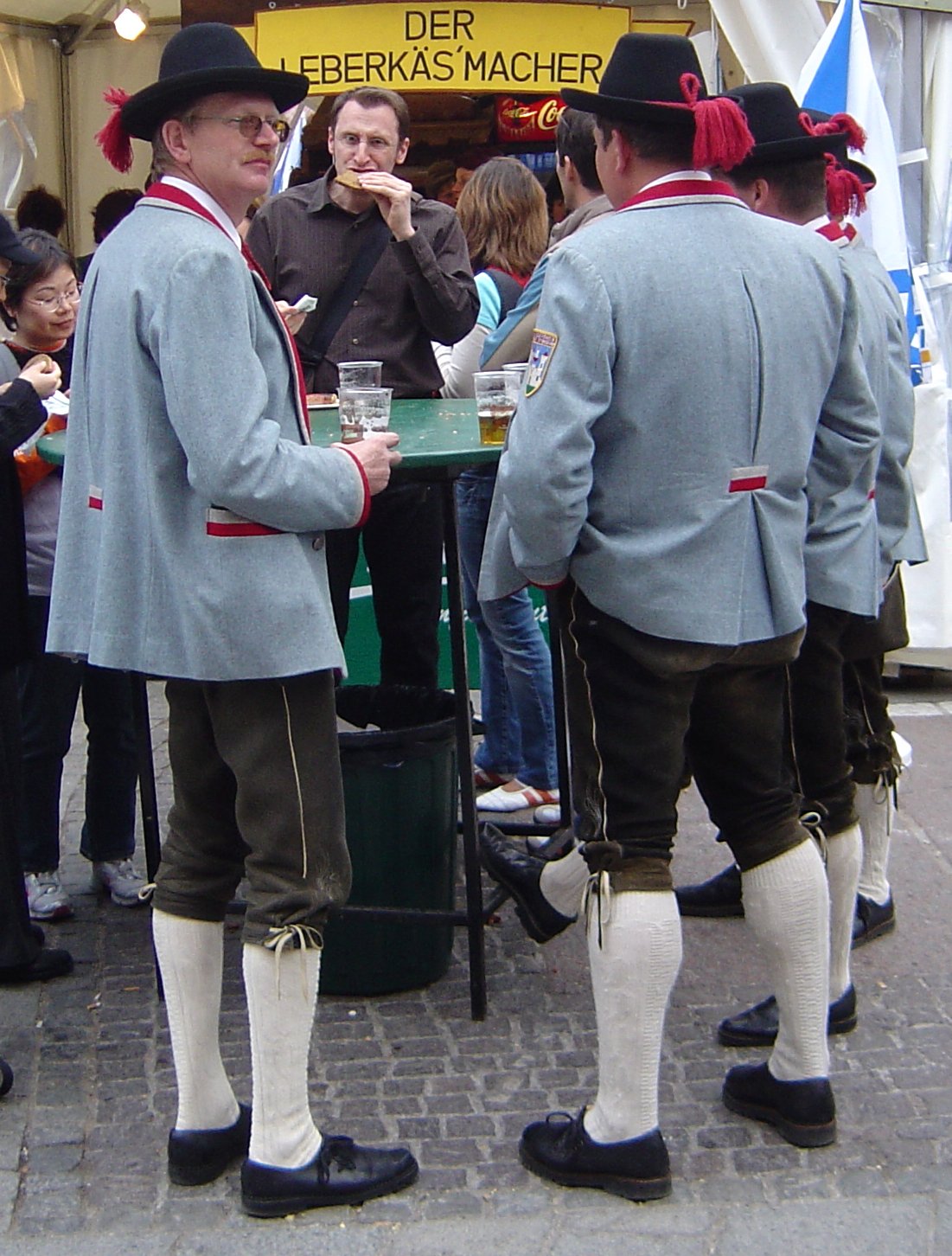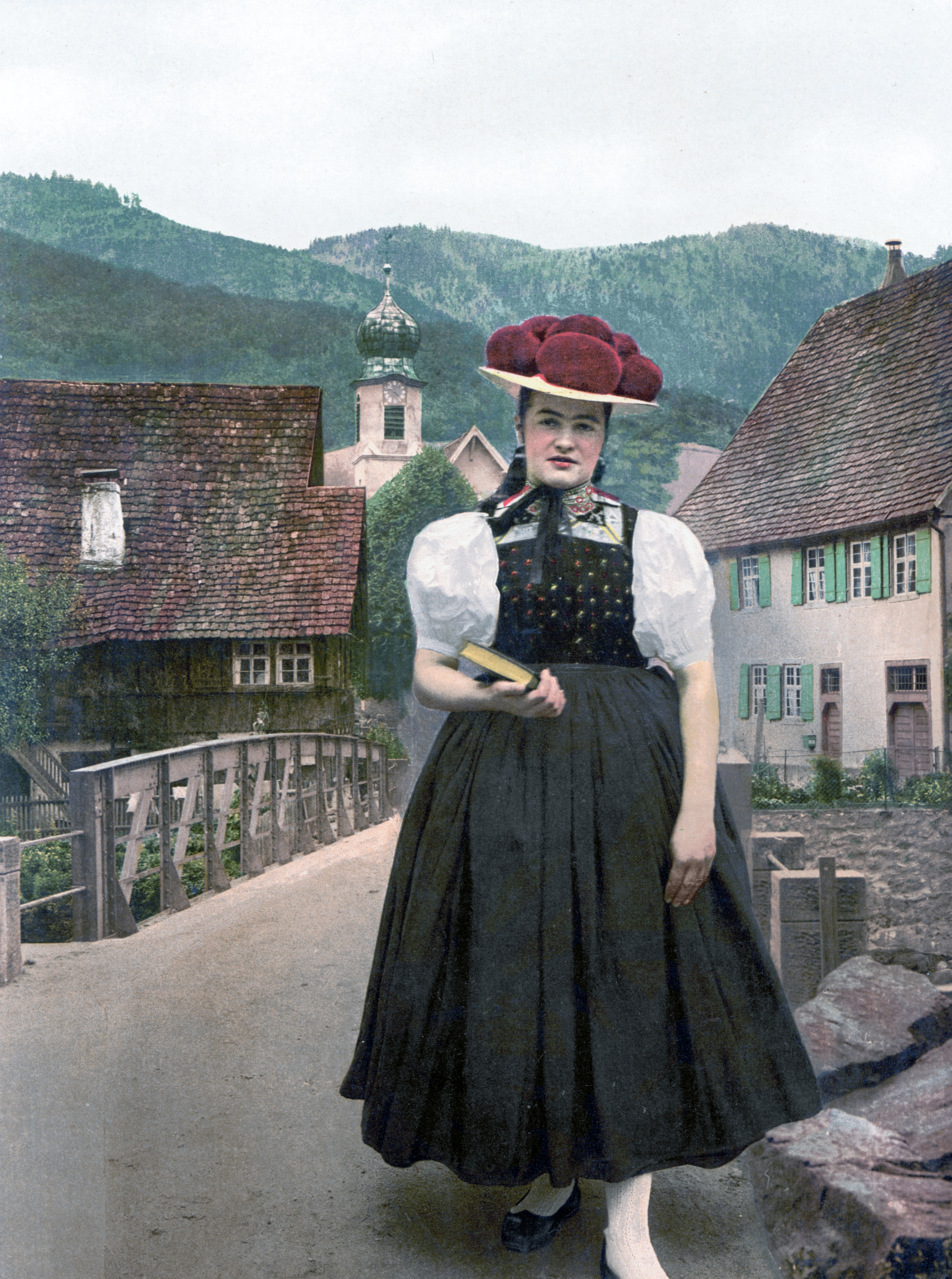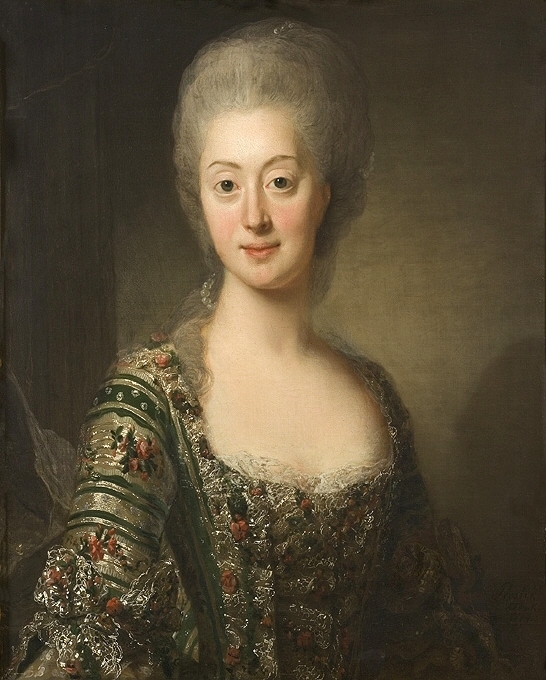|
Tracht
''Tracht'' () refers to traditional garments in German-speaking countries and regions. Although the word is most often associated with Bavarian, Austrian, South Tyrolean and Trentino garments, including lederhosen and dirndls, many other German-speaking peoples have them, as did the former Danube Swabian populations of Central Europe. Name The word "Tracht" comes from the verb "tragen" (to carry or wear); thus the derived noun "Tracht" means "what is worn". So "Tracht" can refer to the clothes which are worn. The noun also has other uses deriving from the verbal meaning, e.g. a load, a device for carrying a load on the shoulders, or the load of honey carried in by the bees). It also appears within the German idiom "eine Tracht Prügel" (a ''load'' (of) beating or, alternately, "a good beating"). "Tracht" is commonly used to refer to the manner of dress associated with a particular ethnic group (''Volkstracht''), social class, or occupation (''Arbeitstracht''). Most often it ... [...More Info...] [...Related Items...] OR: [Wikipedia] [Google] [Baidu] |
Dirndl
A dirndl () is a feminine dress which originated in German-speaking areas of the Alps. It is traditionally worn by women and girls in some Alpine regions of Austria, Germany, Italy, Liechtenstein and Switzerland.Anette Dralle & Christiane Mackenzie (eds.): ''Standardwörterbuch Plus Englisch mit Wörterbuch-App: Englisch-Deutsch, Deutsch-Englisch'', PONS, Stuttgart, 2019, p. 714. A modern dirndl consists of a close-fitting bodice with a low neckline, a blouse worn under the bodice, a wide high-waisted skirt and an apron. The dirndl is regarded as a folk costume (in German ''Tracht''). It developed as the clothing of Alpine peasants between the 16th and 18th centuries. Today it is generally considered traditional dress for women and girls in German-speaking parts of the Alps, with particular designs associated with different regions. The usual masculine tracht counterpart of the dirndl is lederhosen. In the late 19th century the dirndl was adapted by the upper and middle clas ... [...More Info...] [...Related Items...] OR: [Wikipedia] [Google] [Baidu] |
Oktoberfest
Oktoberfest (; ) is the world's largest , featuring a beer festival and a travelling carnival, and is held annually in Munich, Bavaria, from mid- or late-September to the first Sunday in October. The annual event attracts more than seven million international and national visitors at its peak. Locally, it is called , after the colloquial name for the fairgrounds, Theresienwiese. Oktoberfest is an important part of local culture, having been held since the year 1810 (with intermissions). Other cities across the world also hold Oktoberfest celebrations that are modeled after the original Munich event. During the event, large quantities of Oktoberfest Beer are consumed: in 2014, were served. Visitors also enjoy numerous attractions, such as amusement rides, side stalls, and games. There is also a wide variety of traditional foods available. Oktoberfest originally took place in the 16-day period leading up to the first Sunday in October. In 1994, this longstanding schedule was mo ... [...More Info...] [...Related Items...] OR: [Wikipedia] [Google] [Baidu] |
Danube Swabians
The Danube Swabians ( ) is a collective term for the ethnic German-speaking population who lived in the Kingdom of Hungary in east-central Europe, especially in the Danube River valley, first in the 12th century, and in greater numbers in the 17th and 18th centuries. Most were descended from earlier 18th-century Swabian settlers from Upper Swabia, the Swabian Jura, northern Lake Constance, the upper Danube, the Swabian-Franconian Forest, the Southern Black Forest and the Principality of Fürstenberg, followed by Hessians, Bavarians, Franconians and Lorrainers recruited by Austria to repopulate the area and restore agriculture after the expulsion of the Ottoman Empire. They were able to keep their language and religion and initially developed strongly German communities in the region with German folklore. The Danube Swabians were given their German name by German ethnographers in the early 20th century. In the 21st century, they are made up of ethnic Germans from many former and p ... [...More Info...] [...Related Items...] OR: [Wikipedia] [Google] [Baidu] |
Black Forest
The Black Forest ( ) is a large forested mountain range in the States of Germany, state of Baden-Württemberg in southwest Germany, bounded by the Rhine Valley to the west and south and close to the borders with France and Switzerland. It is the source of the Danube and Neckar rivers. Its highest peak is the Feldberg (Black Forest), Feldberg with an elevation of above sea level. Roughly oblong in shape, with a length of and breadth of up to , it has an area of about . Historically, the area was known for forestry and the mining of ore deposits, but tourism has now become the primary industry, accounting for around 300,000 jobs. There are Baroque fortifications in the Black Forest, several ruined military fortifications dating back to the 17th century. History In ancient times, the Black Forest was known as , after the Celtic deity, Abnoba. In Roman times (Late antiquity), it was given the name ("Marcynian Forest", from the Germanic word ''marka'', "border"). The Black ... [...More Info...] [...Related Items...] OR: [Wikipedia] [Google] [Baidu] |
Lederhosen
The term Lederhosen (; , singular in German usage: ''Lederhose'', ; lit. "Leather Pants") is used in English to refer specifically to the traditional leather breeches worn by men in Southern Germany (specifically in Bavaria and Swabia), Austria, South Tyrol and Slovenia. The term '' Trachten Lederhose'' is often used in German to avoid confusion with other types of leather pants. The longer trousers are generally called ''Bundhosen''. History Lederhosen probably originated during the late Middle Ages. They were worn for hard physical work, as they were more durable than fabric garments. Today, they are mostly worn as leisurewear. Lederhosen and dirndl attire are also common at Oktoberfest events around the world. ''La Couturière Parisienne'' stated that lederhosen were originally not exclusively Bavarian garments, but were worn all over Europe, especially by riders, hunters, and other people involved in outdoor activities. The flap (drop front), though, may have been a un ... [...More Info...] [...Related Items...] OR: [Wikipedia] [Google] [Baidu] |
Folk Costume
Folk costume, traditional dress, traditional attire or folk attire, is clothing of an ethnic group, nation or region, and expresses cultural, religious or national identity. An ethnic group's clothing may also be called ethnic clothing or ethnic dress. Traditional clothing includes everyday and formal wear. The word "costume" in this context is sometimes considered pejorative, as the word has more than one meaning, and thus "clothing", "dress", "attire" or "regalia" can be substituted without offense. Following the rise of romantic nationalism in parts of Europe, pre-industrial peasantry came to serve as ideals for genuinity and desirability. Garments evoking peasant dress were made from traditional pre-industrial textiles. In regions where Western dress styles are common, traditional garments are often worn during special events or celebrations. International events may cater to non-Western attendees with a compound dress code such as "business suit or national dress". In s ... [...More Info...] [...Related Items...] OR: [Wikipedia] [Google] [Baidu] |
Föhr
Föhr (; ''Fering'' North Frisian: ''Feer''; ) is one of the North Frisian Islands on the German coast of the North Sea. It is part of the Nordfriesland district in the federal state of Schleswig-Holstein. Föhr is the second-largest North Sea island of Germany and a popular destination for tourists. A town and eleven distinct municipalities are located on the island. The climate is oceanic with moderate winters and relatively cool summers. Being a settlement area already in Neolithic times, Föhr had been part of mainland North Frisia until 1362. Then the coastline was destroyed by a heavy storm flood known as Saint Marcellus's flood (, 'Great Drowning of Men') and several islands were formed, Föhr among them. The northern parts of Föhr consist of marshes while the southern parts consist of sandy geest. From the middle-ages until 1864, Föhr belonged to the Danish realm and to the Duchy of Schleswig, but was then transferred to Prussia as a result of the Second Schleswig Wa ... [...More Info...] [...Related Items...] OR: [Wikipedia] [Google] [Baidu] |
Frisians
The Frisians () are an ethnic group indigenous to the German Bight, coastal regions of the Netherlands, north-western Germany and southern Denmark. They inhabit an area known as Frisia and are concentrated in the Dutch provinces of Friesland and Groningen (province), Groningen and, in Germany, East Frisia and North Frisia (which was a part of Denmark until 1864). The Frisian languages are spoken by more than 500,000 people; West Frisian language, West Frisian is officially recognised in the Netherlands (in Friesland) while North Frisian language, North Frisian and Saterland Frisian language, Saterland Frisian are recognised as regional languages in Germany. Name There are several theories about the origin of the name of the Frisians, which is derived from ''Frisii'' or ''Fresones'', names used by the Romans to describe a Germanic tribe that inhabited the same region but disappeared during the 5th century before the appearance of the Frisians. Most probably the name is derived ... [...More Info...] [...Related Items...] OR: [Wikipedia] [Google] [Baidu] |
Bollenhut
A (, literally "ball-hat") is a formal headdress with distinctive woollen pompoms worn since by Protestant women as part of their folk costume or in the three adjoining Black Forest villages of Gutach, Kirnbach and Hornberg-Reichenbach. The picturesque-looking red has become a symbol of the Black Forest as a whole, despite its rather local origins. The red pom-poms and white brim of the also is said to have inspired the top layer of the Black Forest Cake. Bollenhut as part of folk costume The broad-brimmed, whitewashed straw hat bears 14 prominent woolen pompoms arranged in the shape of a cross. Only eleven pompoms are visible, however, because three are covered by those on top. Unmarried women wear red pompoms, married women wear black, old women and widows wear only the mob cap. The original ''Bollenhut'', which weighed about 500 grams, can now weigh up to and is manufactured by female milliners. The red ''Bollenhut'' may first be worn by girls at their confirma ... [...More Info...] [...Related Items...] OR: [Wikipedia] [Google] [Baidu] |
Trentino
Trentino (), officially the Autonomous Province of Trento (; ; ), is an Autonomous province#Italy, autonomous province of Italy in the Northern Italy, country's far north. Trentino and South Tyrol constitute the Regions of Italy, region of Trentino-Alto Adige/Südtirol, an autonomous region under the constitution. The province is composed of 166 ''comuni'' (: ''comune''). Its capital is the city of Trento (Trent). The province covers an area of more than , with a total population of 541,098 in 2019. Trentino is renowned for its Mountain, mountains, such as the Dolomites, which are part of the Alps. Etymology The province is generally known as "Trentino". The name derives from Trento, the capital city of the province. Originally, the term was used by the local population only to refer to the city and its immediate surroundings. Under former Austrian Empire, Austrian rule, which began in the 19th century (previously, Trentino was governed by the local bishop), the common German ... [...More Info...] [...Related Items...] OR: [Wikipedia] [Google] [Baidu] |
Gustav III
Gustav III (29 March 1792), also called ''Gustavus III'', was King of Sweden from 1771 until his assassination in 1792. He was the eldest son of King Adolf Frederick and Queen Louisa Ulrika of Sweden. Gustav was a vocal opponent of what he saw as the abuse of political privileges seized by the Swedish nobility, nobility since the death of King Charles XII of Sweden, Charles XII in the Great Northern War. Seizing power from the government in a coup d'état, called the Revolution of 1772, Swedish Revolution, in 1772, that ended the Age of Liberty, he initiated a campaign to restore a measure of royal autocracy. This was completed by the Union and Security Act of 1789, which swept away most of the powers exercised by the Swedish Riksdag of the Estates, Riksdag of the estates during the Age of Liberty, but at the same time it opened up the government for all citizens, thereby breaking the privileges of the nobility. A believer in enlightened absolutism, Gustav spent considerable pu ... [...More Info...] [...Related Items...] OR: [Wikipedia] [Google] [Baidu] |
Maximilian Schmidt
Maximilian Schmidt (25 February 1832 Eschlkam – 8 December 1919 Munich) was a German novelist and humorist A humorist is an intellectual who uses humor, or wit, in writing or public speaking. A raconteur is one who tells anecdotes in a skillful and amusing way. Henri Bergson writes that a humorist's work grows from viewing the morals of society .... Biography He served with distinction in the Bavarian army from 1850 to 1872, when he retired and settled at Munich to devote himself exclusively to his literary work. Among the best of his numerous tales and novels, dealing vividly and realistically with the people and scenery of the Bavarian Mountains, should be mentioned: ''Volkserzählungen aus dem Bayrischen Wald'' (Folktales from the Bavarian Woods, 1863-1869); ''Der Schutzgeist von Oberammergau'' (1880); '''s Austragsstüberl''; ''Der Georgithaler'' (1882); ''Die Fischerrosl von St. Heinrich'' (1884); ''Der Musikant von Tegernsee'' (The musician of Tegernsee, 1886); ... [...More Info...] [...Related Items...] OR: [Wikipedia] [Google] [Baidu] |









